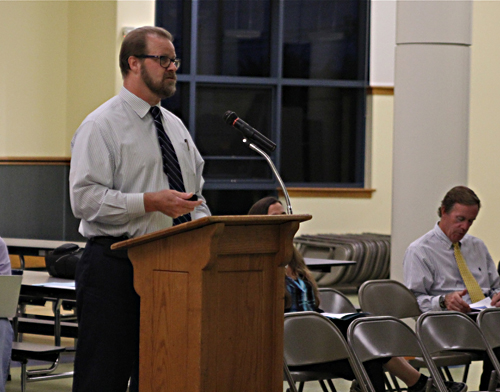Three Riverhead school building projects net $905,000 savings


The Riverhead School District is saving unused funds from completed elementary school renovation projects for potential cost overruns when construction begins later this year at Pulaski Street School and Roanoke Avenue Elementary School, the district’s oldest buildings.
“It’s a tight budget and we’re trying to get the work done at an affordable price,” Superintendent Nancy Carney said. “We’re pleased with the outcome so far and can’t wait until it all comes to fruition.”
Larry Salvesen of BBS Architects in Patchogue and Steve Brugge of Triton Construction in Garden City — the companies working on the district’s $78 million capital improvement bond project approved by voters in 2011 — updated the school board Tuesday night about the districtwide construction plan.
Mr. Brugge said building permits for Pulaski have been secured and he expects to receive building permit approvals for Roanoke within a few weeks.
Capital improvements at Aquebogue, Riley and Phillips were completed last year. Construction at the high school and middle school is currently underway and is scheduled to be completed — along with Pulaski and Roanoke — in fall 2015.
Mr. Brugge said renovation projects at Pulaski include a new kitchen and converting the locker room into classroom space. A four-story addition is slated for Roanoke, he said.
Aquebogue’s final construction cost of about $3.26 million was under budget by nearly $544,920, Ms. Carney said in an email. Riley’s budget came in under $367,000, for a total budget of nearly $5.3 million, she said.
Ms. Carney said the district realized savings because most construction costs came in lower than originally anticipated.
Although the Phillips project went over its original $4 million budget by about $7,000, the net surplus from the other finished projects totals nearly $905,000, she said.
“As projects finish, money that can be released from contingency is reallocated to other buildings,” she said. “This way we ensure that the full authorized bond is spent properly.”
Ms. Carney said the high school’s nearly $34.28 million construction budget has a $1.38 million contingency; the middle school’s $16.69 million budget has a nearly $700,000 contingency; Pulaski’s $7.88 million budget has a roughly $330,000 contingency; and Roanoke’s $7.79 million budget has about a $331,000 contingency.
At Tuesday night’s meeting, Mr. Brugge said the district is “sitting very well” with its capital improvement budget.
“The board has only authorized about $600,000 in change orders in total for the bond referendum and we have a little over $3 million set aside,” he said.
School board president Greg Meyer said Tuesday’s presentation was requested after concerns were raised at the Aug. 26 meeting over a change order involving additional costs to purchase a “floor moisture mitigation product” for the high school’s new fitness room.
School board member Amelia Lantz questioned why the contractor didn’t foresee the problem prior to drafting the project.
“We live on Long Island — moisture is a given thing,” she said. “How come that wasn’t on your radar prior to the change order?”
Mr. Salvesen said the district is better off using contingency funds for those types of projects instead of adding the costs into a proposal.
“It’s not something that you’d want to buy unless you have to buy it,” he said. “If you had built that cost into the bid you could take it back, but the contractor gets to keep his overhead and profit on it — and you’d lose a little bit of money.
“It’s unpredictable,” he added. “That’s part of the reason why you have those contingency funds. They’re there in case something like that does arise.”
Approximately $2.2 million of the overall construction project is being paid for through the district’s repair reserve fund. In 2011, voters approved a referendum to establish a repair-reserve fund of up to $5 million to pay for infrastructure upgrades.







